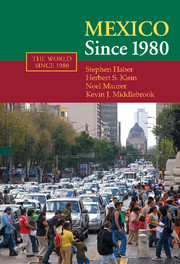Book contents
- Frontmatter
- Contents
- List of Figures
- Acknowledgments
- Abbreviations and Acronyms
- 1 The Second Mexican Revolution: Economic, Political, and Social Change Since 1980
- 2 Mexico Before 1982: The Political Economy of Authoritarian Rule
- 3 The Causes and Consequences of Free Trade
- 4 The Mexican Banking System: The Politics and Economics of Financial Underdevelopment
- 5 The Transformation of Mexican Politics
- 6 Health, Education, and Welfare in Mexico Since 1980
- 7 Democracy and Development in Mexico: Future Challenges and the Legacies of Authoritarian Rule
- Bibliography
- Index
4 - The Mexican Banking System: The Politics and Economics of Financial Underdevelopment
Published online by Cambridge University Press: 05 September 2012
- Frontmatter
- Contents
- List of Figures
- Acknowledgments
- Abbreviations and Acronyms
- 1 The Second Mexican Revolution: Economic, Political, and Social Change Since 1980
- 2 Mexico Before 1982: The Political Economy of Authoritarian Rule
- 3 The Causes and Consequences of Free Trade
- 4 The Mexican Banking System: The Politics and Economics of Financial Underdevelopment
- 5 The Transformation of Mexican Politics
- 6 Health, Education, and Welfare in Mexico Since 1980
- 7 Democracy and Development in Mexico: Future Challenges and the Legacies of Authoritarian Rule
- Bibliography
- Index
Summary
In Chapter Three we discussed the surprisingly slow growth of the Mexican economy once it opened up to foreign trade and investment. We noted that one of the causes of Mexico's sluggish economic performance since the mid-1990s has been the scarcity of credit for firms and households. Indeed, whether we compare Mexico with other members of the Organisation for Economic Co-operation and Development (OECD) or with other Latin American countries, Mexico has an extraordinarily small banking system. As Figure 4.1 demonstrates, in 2005 the ratio of private credit to gross domestic product (GDP) in Mexico was the smallest of any OECD country. Moreover, it was the smallest by a very wide margin, even when compared with the economies of Southern and Eastern Europe. Mexico also does not fare well when compared with other Latin American countries. As Figure 4.2 shows, in 2005 Mexico's banking system, as a percentage of GDP, was dwarfed by those of Chile, Honduras, Uruguay, Bolivia, Costa Rica, Brazil, and even Nicaragua. It was even small by the standards of Ecuador, Peru, Colombia, and Guatemala. In fact, in 2005 there were only two countries in the region with banking systems that were appreciably smaller than Mexico's: Argentina and Venezuela.
Perhaps even more surprising is the fact that Mexico's banking system has been shrinking over time. As Figure 4.3 makes clear, the ratio of bank loans to GDP in Mexico declined drastically between 1994 and 2005.
- Type
- Chapter
- Information
- Mexico since 1980 , pp. 95 - 122Publisher: Cambridge University PressPrint publication year: 2008



